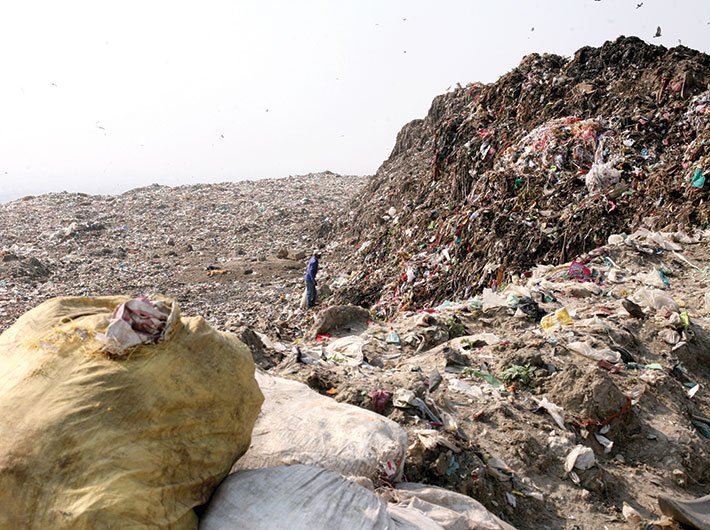Futuristic cities are a good idea, but won't they stink when we don't have waste management policies in place?
The first and foremost requirement of a city to be called smart is cleanliness. Thus, the Swachh Bharat mission was accorded a huge welcome by the media, with good reasons, when it was launched in October 2014. Newspapers had photographs of prominent personalities sweeping the streets. However, there was hardly any news of the ultimate fate of the garbage that goes beyond the frame of such photographs. As most cities are unable to handle the solid waste management (SWM) effectively, the waste generated by households and various economic activities is either littered around public places such as parks, maidans, river banks, or even vacant private lands whose owners are not available in the vicinity. Even in cities where the garbage is collected by the civic authorities, the processing is either absent or available only sub-optimally.
Cities generate, on average, close to half a kilogram of per capita solid waste per day and more affluent cities produce higher quantities. Thus, a city with a population of 10 lakh would be faced with a daily output of five lakh kg of solid waste. If not treated daily, this amount would multiply rapidly. The composition of city waste is complex and includes kitchen waste, green waste, plastic, iron and other metals, paper materials, hospital waste, rubber materials such as tyres and tubes, electronic waste, construction and demolition (C&D) waste, etc.
Untreated solid waste, even after collection from places of origin, spreads out in the environment through air, soil and water. Thus, the task of swachh smart cities can be categorised into (a) efficient collection of solid waste from the source of generation, (b) effective segregation, (c) component-wise processing for recycling, and (d) market-friendly reuse of the recycled materials.
While these four aspects of SWM would appear to be interlinked, each offers its own unique challenges.
Bin-less waste collection
The traditional method of garbage collection expects the householders to place the garbage into nearby dustbins, which are to be cleared by the municipal staff who come with a handcart. Once the cart is full, the staff would empty it into neighbourhood collection bins, commonly called as ‘dhalao’. As for the public places, the municipal staff are expected to sweep and pour the collected waste into the nearest dhalaos. Municipality lorries then empty the dhalaos and take the collected waste to the centralised place, commonly called the ‘garbage dump’. This method has suffered from serious infirmities as householders and commercial establishments keep filling the dhalaos throughout the day, attracting birds and stray dogs to find their feed and, in the process, spread the garbage along with the bacteria and other germs in the environment.
It would be desirable to remove the bins and dhalaos from the framework of garbage collection and ensure direct collection from handcarts into the lorries. In this process, the households would have to dispose of the waste generated by them only once a day, and that too at the appointed time when the handcart arrives, and not throughout the day. Collections in the handcarts from households and from public places would go directly into lorries.
In summary, this arrangement would make the city ‘bin-less’. People who eat fruits while walking, for example, will need to carry the peel home and hand it over to municipal staff the next morning. This will prevent spread of waste along with germs in the environment, make segregation and recycling efficient, and give a cleaner look to the streets.
Effective segregation
The various components of the city waste need different technologies for recycling. In China, the mixed waste is put into incineration for generation of electricity. However, mixed waste would emanate toxic fumes, which would not be acceptable in India, particularly in the wake of highly scattered nature of habitations, which does not leave any large stretch of uninhabited land. Even if it becomes possible to find a large tract of uninhabited territory, incineration of garbage would still be undesirable from pollution point of view. Efforts have been made to trap the fumes, but that distorts the financial viability of the project. Therefore, segregation of the city waste before putting it for recycling is necessary. However, if the entire city waste were brought in one or two or three places for segregation, it would be unrealistic to expect its segregation on a daily basis, in view of the large volumes. Most cities are facing this harsh reality, resulting in the piling up of garbage into heaps that look almost like a hillock, if not a mountain.
The effective solution would be segregation at the source. However, at the household level, it would be unrealistic to segregate the waste into numerous types. The households can have two bins, for dry and wet waste, respectively. Garbage collectors' handcart can also have two compartments accordingly. The truck too can have the same arrangement. However, green waste should preferably be collected independently, as it is normally in huge volumes and from limited sources. At the final off-loading point, further segregation can be handled.
Component-wise recycling
Each type of the waste would need a different method of treatment for recycling. Green waste can be conveniently converted into fuel cakes, household kitchen waste into organic manure, plastic waste into low-density oil and methane gas, paper waste into paper, most metallic waste can be recycled rather conveniently, etc. The C&D waste can be gainfully converted into bricks and tiles. As a thumb rule, five kg kitchen waste would yield one kg manure and the conversion cost would be '1 per kg, while the manure can be sold at '5 per kg, leading to nearly full recovery of the operating costs.
Here is a possibility of inadequate cost recovery in some cases, owing to technology options, quality of the waste and other local factors and such viability gap would need to be funded by the municipality through appropriate taxes or user charges. Technologically speaking, recycling would need to aim at zero net waste and zero landfill. Most cities are conveniently putting the last component of refuge into the soil or landfill, which is an environmentally hazardous option. Governments would need to promote research activities to resolve the issue of recycling of the seemingly unrecyclable remnant of the segregated waste.
Making recycled waste viable for reuse
Technological developments have made it increasingly possible to put the recycled waste into productive use. However, the primary requirement for sustainability of the options for reuse is financial viability, which, in turn, would depend on lowering the input costs, and maximising the realisation from sale of the output from recycling. A major requirement for this would be segregation of the collected waste before recycling. Segregation of waste would enable its processing through specialised plants for each category of waste. Moreover, the quality of the recycled output, such as manure, would be much better with segregated waste materials. Another significant input cost reduction would come from savings in the cost of transportation of the waste from the point of generation to that of processing or recycling. This saving can come about most effectively by setting up decentralised plants.
Decentralised option for SWM
Traditionally, cities adopted the model of waste management based on a single point of disposal, commonly called the ‘dumping yard’. Earlier, the dumping yards used to be on the outskirts of the city with no population or no significant population. However, cities have a natural tendency to expand, resulting in either wholesale absorption of the peri-urban areas or their development as outgrowth habitations. In either situation, the dumping yard becomes a sore point and the residents of the surrounding areas start resenting the dumping yard in their vicinity. As a result, the city starts looking for yet another dumping yard still farther, though in the process, the garbage is required to be transported to still longer distances. In a typical Class 1 city, such transportation distances could run from 10 to 20 km, leading to huge expenditure. Transportation of civic waste to long distances traversing through the various parts of the city is not only sore to sight, but also unhygienic. Moreover, as stated before, piling up of thousands of tonnes of garbage in the centralised dumping yards makes it impossible to segregate the waste into specific types for recycling and invariably leads to burying 20 to 30 percent of the waste into land-fills, which itself creates environmental hazards.
Decentralised waste management systems provide an excellent solution. As of now, systems for recycling household waste with capacities ranging from 100 to 2,000 kg are available in the price range of '20-100 lakh. Besides being light on the municipal budget, such systems offer the great advantage of requiring very little land – of the order of 1,000 to 10,000 square feet only and thus can be installed in every neighbourhood or in the premises of the apartment complexes, campuses of universities, hospitals and similar institutions. Such decentralised systems do away with the need for having dhalaos and even the trucks for transportation of the waste, because the distance between the point of generation and that of processing is reduced to few hundred metres, which can be covered directly by handcarts.
Decentralised systems enable waste segregation on an almost real-time basis, because the quantities collected are small and are amenable to segregation and processing on a daily basis. Once the waste is treated within hours of generation, it does not decompose in the open ambient situation and thus the foul smell and harmful bacteria/germs do not spread out in the environment. Decentralised systems also bring the citizens physically closer to the physical realities of management of the waste that they generate and thus make them more aware and responsible in respect of the issues related to solid waste management.
Decentralised systems make it easier for municipalities to procure the systems and also to operate the same, as the technology and costs are within their capabilities. The municipal staff can also be motivated to indulge in improvisation and innovation in such systems, being relatively simple.
Conclusion
As society advances in terms of economic and social developments, the amount of solid waste generated in the cities is only going to increase and solid waste management is going to remain a real challenge for cities and city managers.
Cost-wise, the recycling of the city waste can definitely be made a viable proposition. While detailed calculations will need to be worked out for each city, as a thumb rule it can be stated that many of the options for solid waste management hold the potential of meeting 30 to 60 percent of the capital and operational expenses through sale of recycled materials, while the balance would need to be realised by way of user charges, which would be in the range of '10 per day for an average household and can be reduced in case of poor residents in an arrangement of cross-subsidies. Decentralised systems offer the added advantage of managerial convenience and can be planned and operated by municipalities conveniently.
With adequate dissemination of information and a bit of handholding, municipalities can find that keeping the city clean is a challenge that they can meet successfully within a short time and within its own resources.
(The story appears in the January 16-31, 2016 issue)

